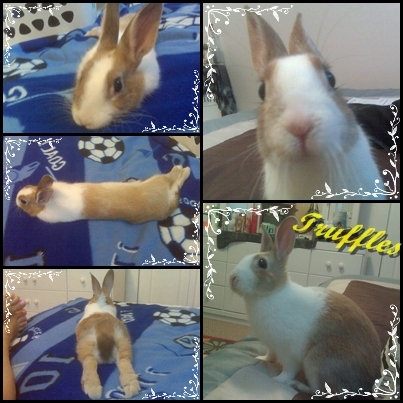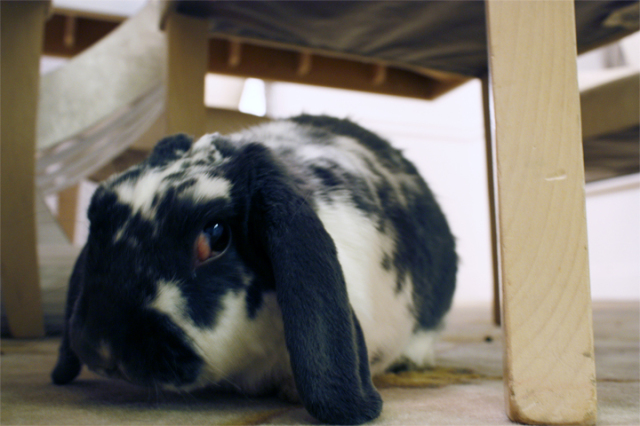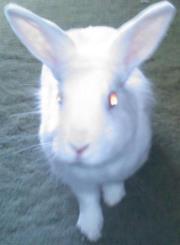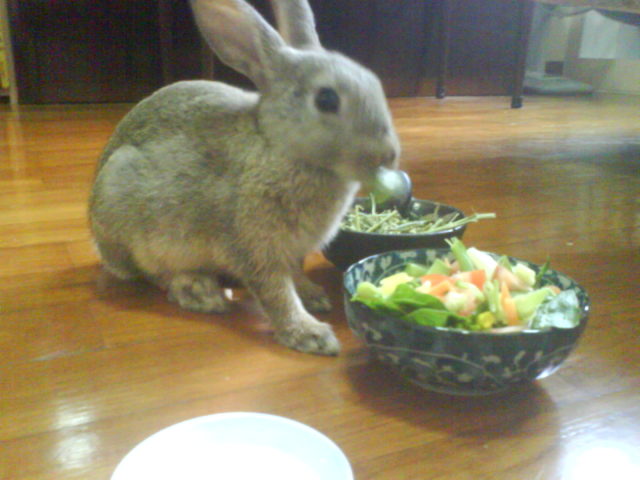QuestionAbout 3 months ago i bought 2 dwarf rabbits, each about 2 months old, a doe and a buck. Up until a week ago they have been living together. Now she's pregnant so we've seperated them. It'll be her first litter. She makes a rumbling noise if u pick her up (which we've been avoiding) and fights the male if we ever put him close. In the corner of her hutch she's been gathering all the wood shavings and making a pile there (a nest?). Is there any way of knowing when she'll kindle? What is the ideal room temperature for her and her coming litter? do u have any extra tips on what to feed her or how to treat the new litter?
AnswerKeep her on a rationed diet. If she is overweight, it can complicate the kindling process and make it dangerous to both the babies and the mother.
She will need a nestbox. A corner of the hutch is not enough to keep the babies contained and warm. The nestbox should be approximately 2" wider and longer than the mother in a normal sitting postition. You can fill it with hay. Be sure to also provide plenty of hay for her to eat each day so she has enough both to eat and make a nest with.
It can be very difficult to know exactly whem a female is ready to kindle. However, most rabbits kindle in the early morning hours or the evening hours, especially if that is the quietest time in your house. Another thing to watch for is for her to start eating less or stop eating all together. Many females will eat less or stop eating shortly before kindling.
The ideal room temperature is going to be about the same for the ideal house temperature for a person. 65-70*F is good, as it is not too warm, but it is also not so cold that the babies will easily get chilled. The most important thing is to avoid any drafts.
When the new litter is born, remove any dead or severely injured kits so they do not rot and infect the healthy kits. In dwarfs, babies that get two of the dwarfing genes will be small and underdeveloped. These are called "peanuts" and they will die. Usually this happens within a few days due to starvation, since their digestive systems are not properly developed. Many people suggest putting these kits down right away to prevent suffering. I agree with this except that on occassions there can be a runt that looks similar to the "peanuts". A runt can survive well (especially with a little extra help), and it can grow up to be a perfectly healthy rabbit.
I try to avoid getting double dwarf babies by breeding a dwarf rabbit to one of the same breed that did not get the dwarfing gene. These are easy to find because anytime you breed two proper dwarfs, there is a 25% chance for peanuts, a 50% chance for proper dwarfs, and a 25% chance for rabbits that did not get the dwarfing gene. That means that usually one or two kits in a litter will be lacking the dwarfing gene. These can still be very useful for breeding. However, even when trying to do this, it is not overly hard to make mistakes from time to time and one of the rabbits you thought did not have the dwarfing gene actually did. In this case, "peanuts" are still possible.
So what I have gone to doing is to wait 3 days before putting any kits down, and any small kits get extra time in with the mom (I make sure of this myself). Any that are obviously growing thinner with this special treatment are likely peanuts, and there is no need for them to continue suffering. This gives the ones that are simple runts the chance to catch up to the rest of their littermates.
For the first 3 or 4 days, handle the babies only long enough to check on their health. After that, if the mother is tolerant, you can increase the amount of time you handle the babies by a small amount each day. They should be handled fairly frequently from about 10 days onward to ensure that they grow up well-socialized and friendly toward people. The 10 day mark is important because that is about the time the babies start to open their eyes.

 sick bunny- pasteurella?
Question
Truffles
Hey There Dana,
sick bunny- pasteurella?
Question
Truffles
Hey There Dana,
 Help me please :(
Question
fur mite
Hello, I have a big problem an
Help me please :(
Question
fur mite
Hello, I have a big problem an
 Blocked Tear Duct?
Question
Eye bulge
Hello,
I want to start off by telli
Blocked Tear Duct?
Question
Eye bulge
Hello,
I want to start off by telli
 My bunny died suddenly.
Question
Alice
I woke up this morning and found
My bunny died suddenly.
Question
Alice
I woke up this morning and found
 Binky and then pees
Question
My Rabbit
Dear Expert,
my rabbit (recently ad
Binky and then pees
Question
My Rabbit
Dear Expert,
my rabbit (recently ad